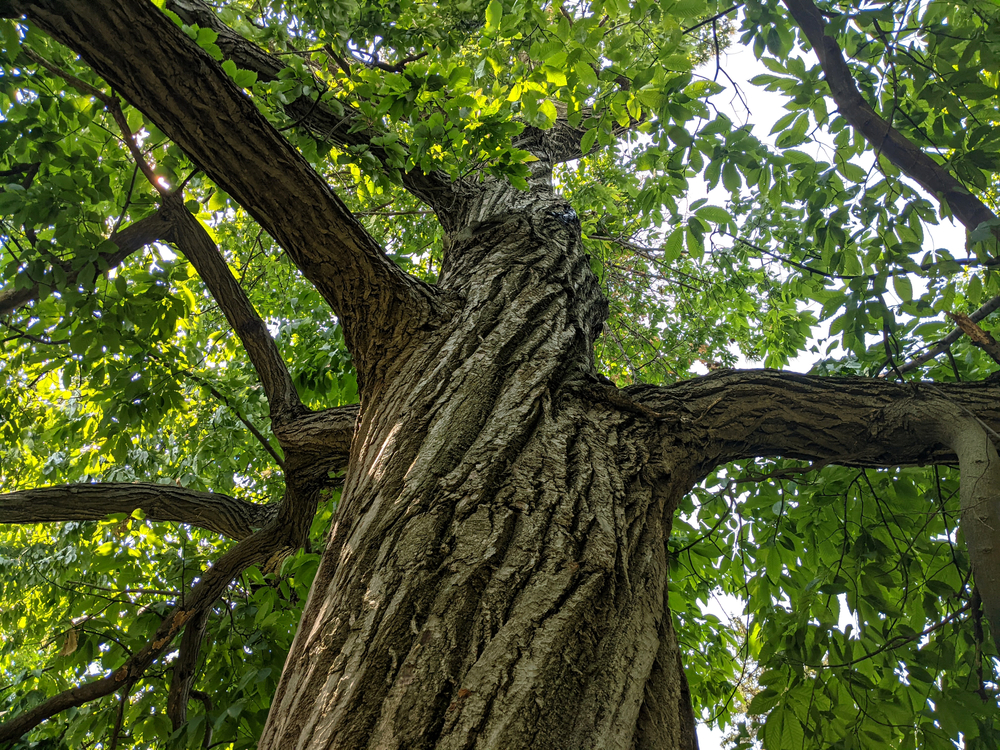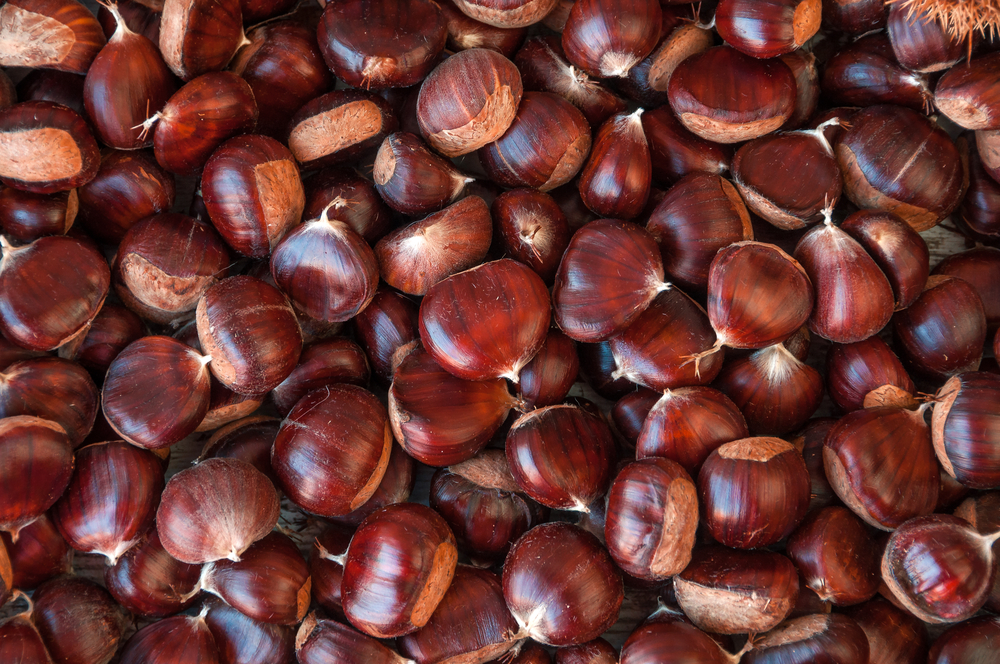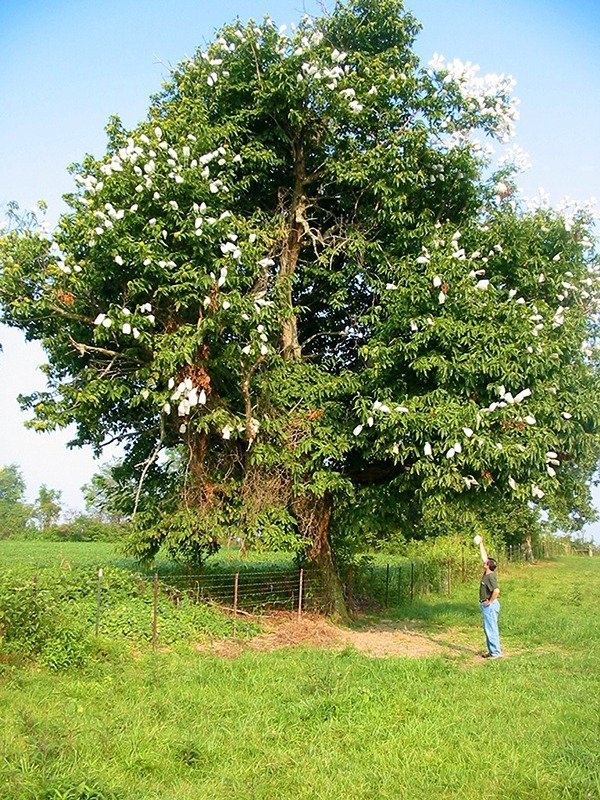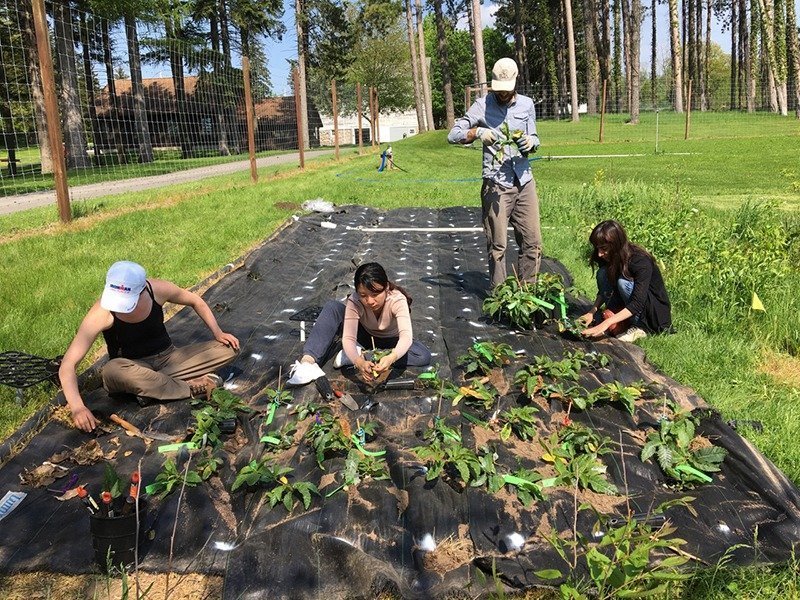More than a century ago, billions of American chestnuts were wiped out by an invasive fungus. Now, scientists are working to restore the tree to its former glory.

As she walks amongst the sea of green, yellow and orange leaves of a chestnut tree orchard, carefully collecting chestnut burrs from the trees, Sara Fitzsimmons, director of restoration for the American Chestnut Foundation, is aware she won’t be around to see the full fruits of her labor. The lifecycle of a tree is much too long for that.
For almost two decades, Fitzsimmons has been working to revive the American chestnut (Castanea dentata), a foundational species that once dominated the Eastern forests of the United States and southern Ontario, Canada. But more than a century ago, the trees were exposed to chestnut blight, an invasive pathogen that was accidentally introduced by imported Asian species of the trees, used mainly for ornamentals and in orchards. American chestnut trees, vulnerable to the fungal disease, were devastated by the blight, leaving behind forests full of toppled trees or stalks with bare, dead branches. Now, 84 percent of chestnut trees in America remain small and are unable to bear fruit.
At one point, there were anywhere between three and five billion American chestnut trees. Today, there are, at most, 435 million still alive. Organizations like the American Chestnut Foundation are working to develop a new, blight-resistant chestnut tree to reintroduce and help revive the population. The timeline? “It’s going to take us between 150 to 200 years to make an ecological impact with millions of seedlings on the landscape,” Fitzsimmons says.
Before blight, American chestnut trees bore importance not just to the ecosystem, but to humans and their way of life. When chestnut trees were abundant, farmers could rely on their nuts as a source of nutrition for their pigs or turkeys. They also often foraged for the nuts to eat as their own food or even trade with. The wood from the trees proved sturdy for building structures, and was used for shingles, beams and flooring in homes, as well as for railroad ties and telegraph or telephone poles.
“The wood was very rot resistant, we had many uses for it. It’s very good at carbon sequestration, which is important in these days with climate change. It’s a really nice habitat for wildlife. And people used to harvest chestnuts this time of year,” says William Powell, director of the American Chestnut Research and Restoration Project at the State University of New York College of Environmental Science and Forestry (SUNY-ESF).

Ripe chestnuts. Photo by karnavalfoto, Shutterstock.
And, of course, they were good for roasting. “You hear that song, ‘chestnuts roasting [on] an open fire,’” Powell says, referencing the classic Christmas song written in 1945 by Robert Wells and Mel Tormé. “That’s American chestnuts. So that was all lost.”
City streets were once lined with carts serving up the sweet, toasty holiday treat. Although chestnuts’ association with the holidays can be traced to sixteenth century Europe, chestnuts grown in North America were known for having a richer, sweeter flavor and were especially suited as a warm treat during winter months. That all changed when blight diminished American chestnut numbers to nearly nothing. Now, any chestnut roasting over an open fire is likely an imported one, as the US is responsible for less than one percent of the crop’s total world production.
Breeding a Better American Chestnut
Despite the massive loss, chestnut trees aren’t technically extinct. In fact, they aren’t even on an endangered list. The blight fungus can’t attack the trees’ root systems due to microorganisms in the soil that act as a protectant. This results in a unique ability for the American chestnut trees to survive at the roots.
But today’s version of a chestnut tree pales in comparison to the trees’ towering ancestors, which used to reach 80 to 100 feet tall with trunk diameters growing around 10 feet. “The problem is that 84 percent of them are only an inch in diameter at breast height,” Fitzsimmons says. “And they’re only about 15 feet tall. They’re not serving the services and ecosystems that the species is supposed to. So we call them functionally extinct.”

A man is dwarfed by a large surviving American chestnut in Kentucky. Photo courtesy of the American Chestnut Foundation.
In its mission to restore the American chestnut by creating a blight-resistant tree, the foundation uses a system that incorporates breeding techniques and biotechnology. One method utilized by the American Chestnut Foundation is known as backcross breeding. For this method, scientists select and move desirable characteristics from one variety to another. The goal is to isolate the blight-resistance genes from another species and incorporate them into the genetic makeup for American chestnut trees. Leila Pinchot, a research ecologist for the US Forest Service who specializes in reintroducing chestnut trees into the forest, explains backcross breeding as an “approach to incorporate the genes for resistance from Chinese chestnut with the American Chestnut because what we want is a tree that looks and acts American.”
Pinchot explains that this method, as shown by geneticist Jared Westbrook’s research for the American Chestnut Foundation, turned out to not be the solution in the case of the chestnut tree. The goal of backcross breeding is to isolate two or three genes, but in the case of the chestnut, “there are so many genes for resistance in the Chinese chestnut, that it’s just not feasible to combine those with the American chestnut and produce a tree that’s mostly American, but still incorporates the genes for systems from Chinese,” says Pinchot. Even so, the backcrossed trees do have higher blight tolerance than a wild tree, and are still planted in forests to supplement the tree population for the time being.
Reading the Wheat Genes
Backcross breeding is not the tree’s only hope. In Powell’s lab at SUNY-ESF, he recently used genetic engineering to develop a blight-resistant tree by combining a single strand of wheat DNA with the DNA of American chestnut. Powell, who has worked on the project for more than 30 years, isolated a gene from wheat, targeting it for its ability to deal with the blight fungus. “The nice thing about this gene is it counteracts how the fungus attacks the tree,” he says.
Powell explains that when blight infects a tree, it starts making acids and enzymes that work in those acids. The main acid it produces, known as oxalic acid, is a toxin that kills the plant cells. The fungus then feeds on those dead cells, forming a structure called a canker that eventually girdles a tree and kills everything above the point of infection. “What this [wheat] gene will do is actually make an enzyme that detoxifies that acid. It breaks it down into hydrogen peroxide and carbon dioxide, two things the plant uses anyway,” Powell says. “So basically we are taking the weapon away from the fungus.” The genetically engineered, or transgenic, trees are known as Darling 58 and are the first of their kind. And while the new trees can still become infected with the same chestnut blight that killed their cousins more than a century ago—and potentially even be slightly damaged by it—the tree will survive.

Planting transgenic seedlings at an orchard in New York. Photo courtesy of the American Chestnut Foundation.
Because of Darling 58’s status as a genetically engineered plant, the next step for getting the trees into forests is a strict regulatory process through the USDA, EPA and the FDA. SUNY-ESF introduced a petition to the USDA in 2020, seeking to deregulate the trees in order to plant them in the wild. This process, Powell hopes will conclude sometime in 2023. In the meantime, more than 2,000 of the Darlings are planted in highly regulated fields, prohibited to flower or spread pollen into the wild. While they await regulations needed to plant trees in forests, Powell’s lab and the American Chestnut Foundation are at work crossing the Darling trees with wild chestnut DNA, hoping to create stronger trees that will grow across the country.
In this way, even with their functionally extinct status, wild chestnut trees are of vital importance to the process of restoring the American chestnut. The wild trees, prominent across regions with vastly different climates—spanning from Georgia all the way up to southern Canada—have adaptive diversity that allow them to thrive within their ecosystems. “Darling 58 is a clone. We can’t restore the American chestnut or any species with a clone,” Fitzsimmons says. “The tree wouldn’t be able to persist in all types of environments. Say I take a chestnut tree from Alabama, and I try to plant it in Maine, at least at this moment, that tree would not survive.” Without adaptive cold tolerance, the chestnut tree would not be viable in a cold region. Crossing the Darling 58 trees with wild chestnut trees allows the diversity the species will need to rejuvenate nationwide.
The foundation relies on impassioned individuals, or citizen scientists to find wild American chestnut matter they can use in the breeding and biotech programs.
And for the next steps in the restoration process, when the time comes to start introducing blight-resistant trees into the American forests, the process is going to be no easier than developing the new tree. Pinchot notes potential ecological challenges in the next steps of revitalizing the species. “We need to know how much light the trees need to grow, and what types of treatments are appropriate for chestnuts to encourage their growth without, again, giving the competitive advantage to other species. That’s really where my research interests lay,” she says. Logistical challenges like growing enough seedlings in nurseries and then successfully transferring them to the forests are also top of mind. As are boots-on-the-ground volunteers, who will be integral in getting the tens of millions of trees planted.
“It’s going to take lots of people, lots of money, lots of energy, lots of time. You know, with trees, nature does it a lot better. But nature can’t do this on her own, and we’re going to have to give her a lot of help,” Fitzsimmons says. “It’s really poetic that I’m helping to work on a project that my forbearers started 100 years ago and it’s gonna take my progeny another 100 years plus to finish. I think that there’s something really cool about that.”
I have a very large chestnut tree on my farm right in front of my house. The bees love it in spring and I have been told that is where bees get the propolis from. The flowers have a lovely fragrance at night. The chestnuts are viable and sprout up everywhere. Knowing what I know now I will transplant them on the edges of my farm.
In the 1950s in my hometown of Damascus, Virginia, my mother (born in 1911), who had known the American chestnut before it was ravaged by the blight had the dream of having them again. She found a man who came to our back yard and grafted the proper stocks onto our trees that were still young enough not to have been attacked. I watched him and his use of twine and beeswax. Very successful. She had two trees that grew up and bore chestnuts abundantly.
I have about fifty seedlings, saplings and a few young trees on my five acre open canopy woodland in Ohio. They are mostly hybrids with a few pure American trees . The biggest problem is the overpopulation of deer that make natural growth of these trees very difficult. The forest has changed and the new chestnut strains will need our help to regain a foothold. Chestnut are not self pollinating, they need to cross every generation. -So they need a fairly dense stand to get good harvests and overcome over foraging.
Would love to receive some of the “Darling58 saplings as our 26 acres of hardwoods is part of a Nature Conservancy and I have a horticultural educational background. It would be awesome to help bring back the American Chestnut! One of my papers in college was of this very same event in history.
We would like to be considered for receiving Darling58 trees for planting in our nature sanctuary
In the early 2000s I planted 2 bare root chestnuts trees in my yard. They initially grew well. They bared a good nut crop for about 2 years. Then 1 of the trees died from the blight. The remaining tree produces a few nuts, but the nuts have no meat inside of them. This past spring I planted two more chestnut trees in my yard, and two in an open spot in the woodlot that I logged. These transplant trees were about 4 ft high. Hopefully in a few years I will the roasting chestnuts with my grandchildren.
It is surprising that the article did not reference the Dunstan Chestnut.
I’m from Central New York State. I have planted a half-dozen Chestnut trees on my property. I would be pleased to take part in any programs of planting Chestnut trees in my area.
I would like to plant a few chestnut trees
I would love to be part of this revival process. I have 24 acres in east central Nebraska aching for trees!